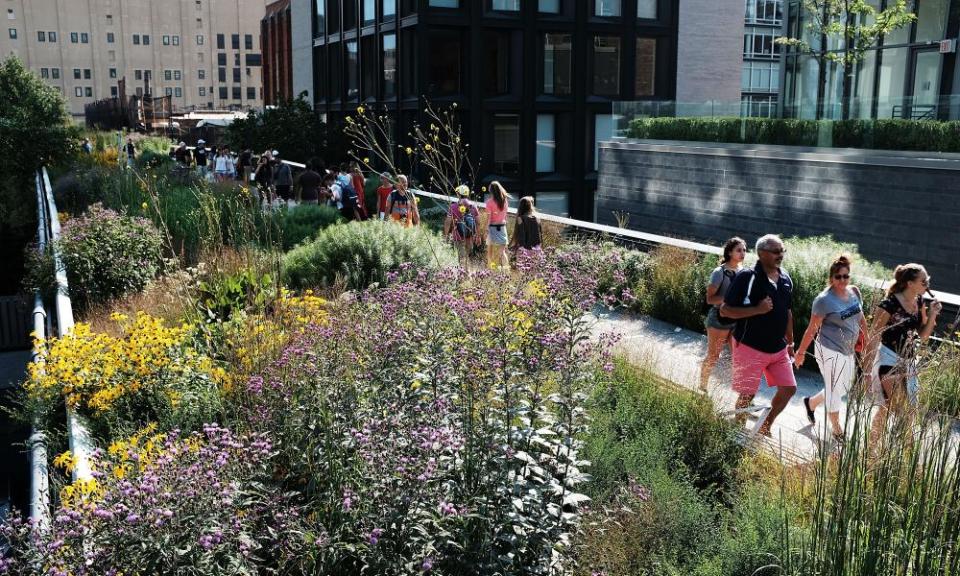Greenery and bright colours in cities can boost morale – study
Having bright colours and greenery in our cities can make people happier and calmer, according to an unusual experiment involving virtual reality headsets.
Related: Cities need to be redesigned for the climate crisis. Can they make us happy, too?
A team of researchers at the University of Lille, in France, used VR to test how volunteers reacted to variations of a minimalist concrete, glass and metal urban landscape. The 36 participants walked on the spot in a laboratory wearing a VR headset with eye trackers, and researchers tweaked their surroundings, adding combinations of vegetation, as well as bright yellow and pink colours, and contrasting, angular patterns on the path.
By tracking their blink rate, the researchers learned about what the volunteers were most interested in. The participants then filled out a questionnaire about their experience.
The researchers found that the volunteers walked more slowly and their heart rate increased when they saw green vegetation in their urban setting. They also kept their heads higher, looking forward and around, instead of towards the ground. While adding and taking away colour didn’t make quite as much of a difference for the participants, they were more curious and alert when colourful patterns were added to the ground they were virtually stepping on, according to the study. According to Yvonne Delevoye-Turrell, a professor of cognitive psychology at the university and the lead author on this study, the results demonstrated that the urban experience had been made more pleasurable.
The research, published on Friday in Frontiers in Virtual Reality, suggests that making some small tweaks to the city boosts morale, even when people are experiencing them through virtual reality. “We think that the variations in human behaviour obtained in virtual reality can predict the changes that would be obtained in the natural settings,” said Delevoye-Turrell.
Michal Matlon, an architecture psychologist and consultant, who was not involved in the study, said: “I think that though most people appreciate nature in cities – they find it beautiful, and they usually react with anger when it’s taken away – they don’t fully understand how beneficial spending time in nature is.
“We often underappreciate the compounding effects that enriching ordinary places with nature can have.”
Matlon said even the smallest of changes, as demonstrated in the study, could affect the experience of someone on their way to work, for example.

The findings are part of a growing body of research into the restorative effects of vegetation and colour in urban settings.
However, Steffen Lehmann, a professor of architecture at the University of Nevada, in the US, who was not involved in the study, wondered whether a VR simulation could provide the input to back up the thesis. He said he was also concerned that the study was reductive.
“It is not particularly useful to build a scientific argument on the dichotomy, ‘concrete versus vegetation’,” he said. “[This issue] requires a more differentiated and nuanced discussion.”
Delevoye-Turrell said using VR to carry out the study was fundamental to the experiment, because testing the elements in real-life environments would mean very little control of the distractions participants experience, such as noise, traffic or weather changes.
“We have reached the technological capacities to produce a virtual environment that offers similar immersive experiences, [in contrast to] the natural settings,” said Delevoye-Turrell.
In future research, she said she planned to also measure physiological changes, such as temperature, and add smells and sound to create multi-sensory, immersive environments.

 Yahoo Sports
Yahoo Sports 